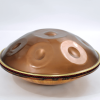
Abstract
Our customers often ask whether we tune Guda Drums to "432 Hz scale". YES, we tune them. By default, we tune our instruments at the standard frequency, in which the note A = 440 Hz. However, if customers ask to tune Guda " in 432 Hz", then we tune it.
What does "432 Hz" mean? Many of our customers ask to do "432 Hz tuning", not quite understanding what exactly it means.
432 Hz is the frequency of the note A second octave. I.e. the gamma is tuned so that the A of 2 octave corresponds exactly to 432 Hz (we recall that the standard is a system in which the A of 2 octave corresponds to 440 Hz).
There are quite a lot of prejudices and misconceptions associated with this figure, which we will try to explain in this article. We would like to say that we have a neutral attitude to 432 Hz tunings, we like their sound as well as 440 Hz. But we decided to clarify some facts because we want our clients to be 100% satisfied with their choice
432 Hz scale: the origin and the influence on the human body. Truth or lie?
Recently, more and more often on the Internet, you can see publications relating to the tuning of musical instruments and, in general, listening to music at the particular frequency. The most frequently found articles are about a more positive effect of the 432 Hz compared to the standard 440 Hz. The usage of it is now widespread. And many authors run to extremes and call one of the alternative frequency settings of musical instruments (when the note A corresponds to a frequency of acoustic oscillations of 432 Hz) the frequency of "vibrations of the Universe," "divine," "healing." At the same time, the usage of 440 Hz "carries a negative connotation, suppresses and depresses." Besides, "it was invented and introduced personally either by Hitler or Rockefeller, to seize control of the world and the minds of people". It may sound funny, but if you enter "432Hz" in the web search engine, you risk to be buried under tons of pseudo-scientific articles on this topic with lots of inaccuracies, insinuations, and utter rubbish. Still, now we try to sort out this issue. Fortunately, searching for information has become much easier nowadays. So, we will compartmentalize the main postulates of "witnesses of the frequency of 432 Hz church."
In this publication, we play the role of the guys from the popular program "Myth Busters" and try to confirm or refute some of the stereotypes around the subject of our article.
- Myth number one: Even in Ancient Egypt and Greece, musical instruments were tuned to 432 Hz as their base pitch. Plato and Pythagoras wrote about the frequency of 432 Hz.
In those days, instruments were being tuned by ear, so the number of settings was much more than two. Also, it is not entirely clear what is the base of such generalizing statement. The number of musical instruments that were used then, compared to the number that has come to us (and is not in tatters) through the millennia, is just insignificant to make such a comprehensive review.
If we talk about Ancient Greece and the "Pythagoras' system" (the system where the Doh note = 256 Hz, and all the other ones were calculated at pure intervals), so according to it the note A=426.7 Hz. Also, we would like to notice that "Hertz" is a modern term coined in 1930.
BUSTED
- Myth number two: In European classical music, until the standardization of 440 Hz (1939), the pitch was 432, Mozart himself created at 432 Hz.
In Europe (as well as on the whole planet), not only in different countries instruments were tuned in various ways, but in different cities as well; there was not and could not be a single standard. It came to the point that in two nearby churches in one street instruments could be tuned to different tuning-forks. The frequencies for the A note varied from 390 to 460 Hz. And this is the known facts, for example, in the European musical museums, the pitchforks of those distant years have been preserved. For instance, the first tuning-fork, produced by John Shore in 1711, was at a frequency of 423.5 Hz.
Moreover, within even one genre there were already established and different standards. For example, in Baroque music:
- For the northern Italian Baroque (Gabrieli, Monteverdi, etc.) - 460 Hz.
- For French and South Italian Baroque - 392 Hz.
- For the Viennese classics (Mozart, Haydn, etc.) and early Romanticism (1750-1850) - 430 Hz
- For the performance of German choral and organ music of the XVIIth - 415 Hz
In Russia was applied so-called "St. Petersburg tuning-fork" from the end of the XVIII century to 1885; its frequency was at 436 Hz.
BUSTED
- Myth number three: Everything was fine, as long as Hitler (Gebels, Rockefeller) did not fix the tuning standard at 440 Hz.
In fact, the frequency 440 was used long before 1930-1940 on a par with other frequencies. The reason why at the beginning of the 20th century the tuning frequencies were fixed in the range from 430 to 440 Hz is a development of concert music. The orchestras became more and more extensive and loud, the sound reinforcement system was not invented yet, and it was necessary to solve the problem of "brightness" of the instruments sounding so that they "cut" the general sound of an orchestra. That fact caused a tendency for the instrument manufacturers to rise in pitch gradually. But it was impossible to do it endlessly, as there was another problem - the dissatisfaction of the vocalists. General tendency to rise in pitch led to the necessity to sing at frequencies which were not comfortable for a human voice. As for the year 1939, when the standard of 440 Hz was adopted in Germany, then there was probably a case of the well-known German pragmatism and the desire for standardization rather than conspiracy theories, masons and other horrors that the yellow press feeds its readers.
It is documented that the tuning of 440 Hz was used 105 years before the introduction of the German standard. A few historical facts:
- In 1834 when at the conference in Stuttgart the Congress of Physicists hears the recommendations of Heinrich Scheibler regarding the fixation of the note A= 440 Hz and examines the related results of the research conducted by the scientist on a specially created instrument (Tonometer Scheibler). The device, and its surprisingly accurate measurement method, described in Scheibler's book The Physical and Musical Tonometer.
- 28 years later another well-known scientist, Hermann Helmholtz publishes a scientific work titled "On the sensations of tone as the physiological basis of the theory of music," where he relies on the frequency of 440 Hz as the fundamental one. A link to the book
- 1836 -The Paris Orchestra is tuned by the tuning-fork A = 441.
- 1896 - The Royal Philharmonic of Great Britain uses a tuning-fork A = 441.
BUSTED
In the light of all the above facts, several conclusions can be drawn:
- Musicians of all times always persistently searched for the most successful tuning of their instruments.
- Throughout the musical history, humanity "flexible" approached the tuning of musical instruments, experimenting with different frequencies.
- To date, there is not a single scientific work, a book or a serious study concerning the frequency of 432 Hz, that would confirm or, on the contrary, completely reject the distinctly beneficial effects of this frequency for tuning compared to 440 Hz or other. Perhaps this is precisely connected with the lack of an object of investigation and the fact of "exceptional" distinctiveness.
In conclusion, I would like to say a few words about my attitude to this topic.
It is indisputable that music and its physical components - frequency, loudness, vibrations have a huge impact on the human body. This influence has not been fully studied yet, and I am sure that in this area we still have a lot of incredible discoveries, the main thing is that people with a cool head and the corresponding high-tech equipment came there. In our workshop, we tune our instruments as at the standard 440 frequency and 432 also, and I spend a lot of time playing the instruments tuned in different ways. Since the frequency 440 has established for a very long time, as the standard one, 99% of what we hear on the radio or TV- is tuned to this frequency. When you take an instrument tuned in 432, the very nature of its sound is already intriguing, it is perceived differently, and it seems unusual because such sound would not be heard in ordinary life. This fact captivates, gives step up for imagination and fantasy and as a result, new musical ideas arise, and in the end, all this leads to a change in the sense of the playing. Which way? Well, everything is very individual, and it is up to you ))






